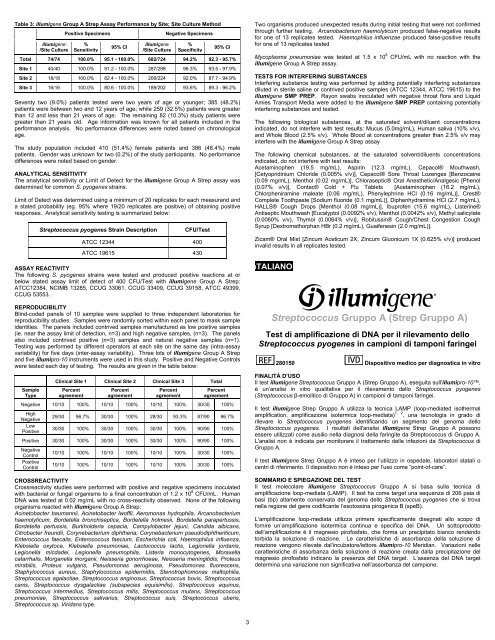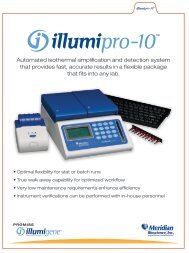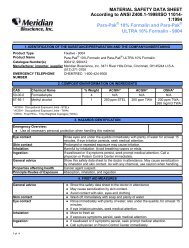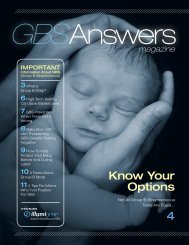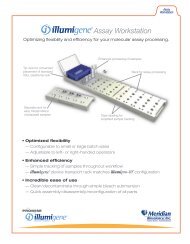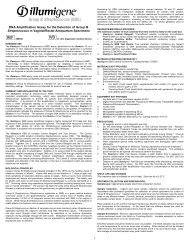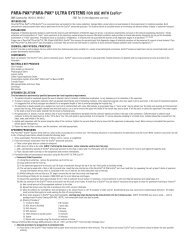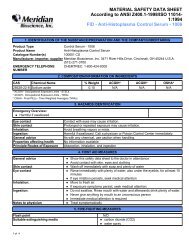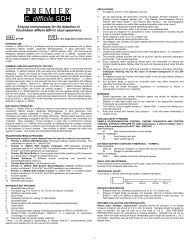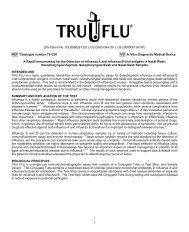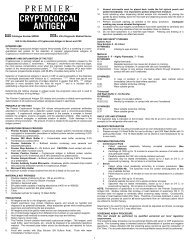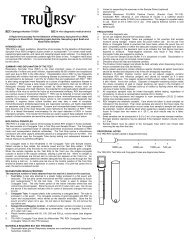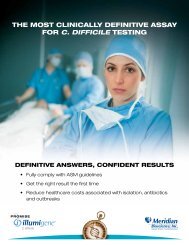Group A Streptococcus (Group A Strep) - Meridian Bioscience, Inc.
Group A Streptococcus (Group A Strep) - Meridian Bioscience, Inc.
Group A Streptococcus (Group A Strep) - Meridian Bioscience, Inc.
Create successful ePaper yourself
Turn your PDF publications into a flip-book with our unique Google optimized e-Paper software.
Table 3: illumigene <strong>Group</strong> A <strong>Strep</strong> Assay Performance by Site; Site Culture Method<br />
illumigene<br />
/Site Culture<br />
Positive Specimens Negative Specimens<br />
%<br />
Sensitivity<br />
95% CI<br />
illumigene<br />
/Site Culture<br />
%<br />
Specificity<br />
95% CI<br />
Total 74/74 100.0% 95.1 - 100.0% 682/724 94.2% 92.3 - 95.7%<br />
Site 1 40/40 100.0% 91.2 - 100.0% 287/298 96.3% 93.5 - 97.9%<br />
Site 2 18/18 100.0% 82.4 - 100.0% 206/224 92.0% 87.7 - 94.9%<br />
Site 3 16/16 100.0% 80.6 - 100.0% 189/202 93.6% 89.3 - 96.2%<br />
Seventy two (9.0%) patients tested were two years of age or younger; 385 (48.2%)<br />
patients were between two and 12 years of age; while 259 (32.5%) patients were greater<br />
than 12 and less than 21 years of age. The remaining 82 (10.3%) study patients were<br />
greater than 21 years old. Age information was known for all patients included in the<br />
performance analysis. No performance differences were noted based on chronological<br />
age.<br />
The study population included 410 (51.4%) female patients and 386 (48.4%) male<br />
patients. Gender was unknown for two (0.2%) of the study participants. No performance<br />
differences were noted based on gender.<br />
ANALYTICAL SENSITIVITY<br />
The analytical sensitivity or Limit of Detect for the illumigene <strong>Group</strong> A <strong>Strep</strong> assay was<br />
determined for common S. pyogenes strains.<br />
Limit of Detect was determined using a minimum of 20 replicates for each measurand and<br />
a stated probability (eg. 95% where 19/20 replicates are positive) of obtaining positive<br />
responses. Analytical sensitivity testing is summarized below:<br />
<strong><strong>Strep</strong>tococcus</strong> pyogenes Strain Description CFU/Test<br />
ATCC 12344 400<br />
ATCC 19615 430<br />
ASSAY REACTIVITY<br />
The following S. pyogenes strains were tested and produced positive reactions at or<br />
below stated assay limit of detect of 400 CFU/Test with illumigene <strong>Group</strong> A <strong>Strep</strong>:<br />
ATCC12384, NCIMB 13285, CCUG 33061, CCUG 33409, CCUG 39158, ATCC 49399,<br />
CCUG 53553.<br />
REPRODUCIBILITY<br />
Blind-coded panels of 10 samples were supplied to three independent laboratories for<br />
reproducibility studies. Samples were randomly sorted within each panel to mask sample<br />
identities. The panels included contrived samples manufactured as low positive samples<br />
(ie. near the assay limit of detection, n=3) and high negative samples, (n=3). The panels<br />
also included contrived positive (n=3) samples and natural negative samples (n=1).<br />
Testing was performed by different operators at each site on the same day (intra-assay<br />
variability) for five days (inter-assay variability). Three lots of illumigene <strong>Group</strong> A <strong>Strep</strong><br />
and five illumipro-10 instruments were used in this study. Positive and Negative Controls<br />
were tested each day of testing. The results are given in the table below:<br />
Sample<br />
Type<br />
Clinical Site 1 Clinical Site 2 Clinical Site 3 Total<br />
Percent<br />
agreement<br />
Percent<br />
agreement<br />
Percent<br />
agreement<br />
Percent<br />
agreement<br />
Negative 10/10 100% 10/10 100% 10/10 100% 30/30 100%<br />
High<br />
Negative<br />
Low<br />
Positive<br />
29/30 96.7% 30/30 100% 28/30 93.3% 87/90 96.7%<br />
30/30 100% 30/30 100% 30/30 100% 90/90 100%<br />
Positive 30/30 100% 30/30 100% 30/30 100% 90/90 100%<br />
Negative<br />
Control<br />
Positive<br />
Control<br />
10/10 100% 10/10 100% 10/10 100% 30/30 100%<br />
10/10 100% 10/10 100% 10/10 100% 30/30 100%<br />
CROSSREACTIVITY<br />
Crossreactivity studies were performed with positive and negative specimens inoculated<br />
with bacterial or fungal organisms to a final concentration of 1.2 x 10 8 CFU/mL. Human<br />
DNA was tested at 0.02 mg/mL with no cross-reactivity observed. None of the following<br />
organisms reacted with illumigene <strong>Group</strong> A <strong>Strep</strong>:<br />
Acinetobacter baumannii, Acinetobacter lwoffii, Aeromonas hydrophila, Arcanobacterium<br />
haemolyticum, Bordetella bronchiseptica, Bordetella holmesii, Bordetella parapertussis,<br />
Bordetella pertussis, Burkholderia cepacia, Campylobacter jejuni, Candida albicans,<br />
Citrobacter freundii, Corynebacterium diphtheria, Corynebacterium pseudodiphtheriticum,<br />
Enterococcus faecalis, Enterococcus faecium, Escherichia coli, Haemophilus influenza,<br />
Klebsiella oxytoca, Klebsiella pneumoniae, Lactococcus lactis, Legionella jordanis,<br />
Legionella micdadei, Legionella pneumophila, Listeria monocytogenes, Moraxella<br />
catarrhalis, Morganella morganii, Neisseria gonorrhoeae, Neisseria meningitidis, Proteus<br />
mirabilis, Proteus vulgaris, Pseudomonas aeruginosa, Pseudomonas fluorescens,<br />
Staphylococcus aureus, Staphylococcus epidermidis, Stenotrophomonas maltophilia,<br />
<strong><strong>Strep</strong>tococcus</strong> agalactiae, <strong><strong>Strep</strong>tococcus</strong> anginosus, <strong><strong>Strep</strong>tococcus</strong> bovis, <strong><strong>Strep</strong>tococcus</strong><br />
canis, <strong><strong>Strep</strong>tococcus</strong> dysgalactiae (subspecies equisimilis), <strong><strong>Strep</strong>tococcus</strong> equinus,<br />
<strong><strong>Strep</strong>tococcus</strong> intermedius, <strong><strong>Strep</strong>tococcus</strong> mitis, <strong><strong>Strep</strong>tococcus</strong> mutans, <strong><strong>Strep</strong>tococcus</strong><br />
pneumoniae, <strong><strong>Strep</strong>tococcus</strong> salivarius, <strong><strong>Strep</strong>tococcus</strong> suis, <strong><strong>Strep</strong>tococcus</strong> uberis,<br />
<strong><strong>Strep</strong>tococcus</strong> sp. Viridans type.<br />
3<br />
Two organisms produced unexpected results during initial testing that were not confirmed<br />
through further testing. Arcanobacterium haemolyticum produced false-negative results<br />
for one of 13 replicates tested. Haemophilus influenzae produced false-positive results<br />
for one of 13 replicates tested<br />
Mycoplasma pneumoniae was tested at 1.5 x 10 6 CFU/mL with no reaction with the<br />
illumigene <strong>Group</strong> A <strong>Strep</strong> assay.<br />
TESTS FOR INTERFERING SUBSTANCES<br />
Interfering substance testing was performed by adding potentially interfering substances<br />
diluted in sterile saline or contrived positive samples (ATCC 12344, ATCC 19615) to the<br />
illumigene SMP PREP. Rayon swabs inoculated with negative throat flora and Liquid<br />
Amies Transport Media were added to the illumigene SMP PREP containing potentially<br />
interfering substances and tested.<br />
The following biological substances, at the saturated solvent/diluent concentrations<br />
indicated, do not interfere with test results: Mucus (5.0mg/mL), Human saliva (10% v/v),<br />
and Whole Blood (2.5% v/v). Whole Blood at concentrations greater than 2.5% v/v may<br />
interfere with the illumigene <strong>Group</strong> A <strong>Strep</strong> assay<br />
The following chemical substances, at the saturated solvent/diluents concentrations<br />
indicated, do not interfere with test results:<br />
Acetaminophen (19.5 mg/mL), Aspirin (12.3 mg/mL), Cepacol® Mouthwash,<br />
[Cetyopridinium Chloride (0.005% v/v)], Cepacol® Sore Throat Lozenges [Benzocaine<br />
(0.09 mg/mL), Menthol (0.02 mg/mL)], Chloraseptic® Oral Anesthetic/Analgesic [Phenol<br />
(0.07% v/v)], Contac® Cold + Flu Tablets [Acetaminophen (16.2 mg/mL),<br />
Chlorpheniramine maleate (0.06 mg/mL), Phenylephrine HCl (0.16 mg/mL)], Crest®<br />
Complete Toothpaste [Sodium fluoride (0.1 mg/mL)], Diphenhydramine HCl (2.7 mg/mL),<br />
HALLS® Cough Drops [Menthol (0.08 mg/mL)], Ibuprofen (15.6 mg/mL), Listerine®<br />
Antiseptic Mouthwash [Eucalyptol (0.0092% v/v), Menthol (0.0042% v/v), Methyl salicylate<br />
(0.0060% v/v), Thymol (0.0064% v/v)], Robitussin® Cough/Chest Congestion Cough<br />
Syrup [Dextromethorphan HBr (0.2 mg/mL), Guaifenesin (2.0 mg/mL)].<br />
Zicam® Oral Mist [Zincum Aceticum 2X, Zincum Gluonicum 1X (0.625% v/v)] produced<br />
invalid results in all replicates tested.<br />
ITALIANO<br />
<strong><strong>Strep</strong>tococcus</strong> Gruppo A (<strong>Strep</strong> Gruppo A)<br />
Test di amplificazione di DNA per il rilevamento dello<br />
<strong><strong>Strep</strong>tococcus</strong> pyogenes in campioni di tamponi faringei<br />
280150 Dispositivo medico per diagnostica in vitro<br />
FINALITÀ D’USO<br />
Il test illumigene <strong><strong>Strep</strong>tococcus</strong> Gruppo A (<strong>Strep</strong> Gruppo A), eseguita sull'illumipro-10,<br />
è un’analisi in vitro qualitativa per il rilevamento dello <strong><strong>Strep</strong>tococcus</strong> pyogenes<br />
(<strong><strong>Strep</strong>tococcus</strong> β-emolitico di Gruppo A) in campioni di tamponi faringei.<br />
Il test illumigene <strong>Strep</strong> Gruppo A utilizza la tecnica LAMP (loop-mediated isothermal<br />
amplification, amplificazione isotermica loop-mediata) 1, 2 , una tecnologia in grado di<br />
rilevare lo <strong><strong>Strep</strong>tococcus</strong> pyogenes identificando un segmento del genoma dello<br />
<strong><strong>Strep</strong>tococcus</strong> pyogenes. I risultati dell'analisi illumigene <strong>Strep</strong> Gruppo A possono<br />
essere utilizzati come ausilio nella diagnosi della faringite da <strong><strong>Strep</strong>tococcus</strong> di Gruppo A.<br />
L'analisi non è indicata per monitorare il trattamento delle infezioni da <strong><strong>Strep</strong>tococcus</strong> di<br />
Gruppo A.<br />
Il test illumigene <strong>Strep</strong> Gruppo A è inteso per l’utilizzo in ospedale, laboratori statali o<br />
centri di riferimento. Il dispositivo non è inteso per l’uso come “point-of-care”.<br />
SOMMARIO E SPIEGAZIONE DEL TEST<br />
Il test molecolare illumigene <strong><strong>Strep</strong>tococcus</strong> Gruppo A si basa sulla tecnica di<br />
amplificazione loop-mediata (LAMP). Il test ha come target una sequenza di 206 paia di<br />
basi (bp) altamente conservata del genoma dello <strong><strong>Strep</strong>tococcus</strong> pyogenes che si trova<br />
nella regione del gene codificante l’esotossina pirogenica B (speB).<br />
L’amplificazione loop-mediata utilizza primers specificamente disegnati allo scopo di<br />
fornire un’amplificazione isotermica continua e specifica del DNA. Un sottoprodotto<br />
dell’amplificazione è il magnesio pirofosfato, che forma un precipitato bianco rendendo<br />
torbida la soluzione di reazione. Le caratteristiche di assorbanza della soluzione di<br />
reazione vengono rilevate dal’incubatore/lettore illumipro-10 <strong>Meridian</strong>. Variazioni nelle<br />
caratteristiche di assorbanza della soluzione di reazione creata dalla precipitazione del<br />
magnesio pirofosfato indicano la presenza del DNA target. L’assenza del DNA target<br />
determina una variazione non significativa nell’assorbanza del campione.


